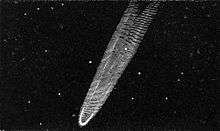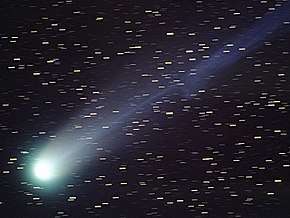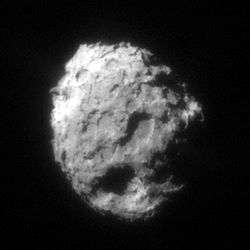Great Comet of 1819
The Great Comet of 1819, officially designated as C/1819 N1, also known as Comet Tralles, was an easily visible brilliant comet, approaching an apparent magnitude of 1–2, discovered July 1, 1819 by Johann Georg Tralles in Berlin, Germany. It was the first comet analyzed using polarimetry, by François Arago.[3][4]
 Great Comet of 1819, from Uranography drawn by E. Otis Kendall (1850)[1] | |
| Discovery | |
|---|---|
| Discovered by | Johann Georg Tralles |
| Discovery date | July 1, 1819 |
| Alternative designations | 1819 II, Great Comet of 1819 Comet Tralles |
| Orbital characteristics A | |
| Epoch | 2385613.5 (1819-Jun-28.0)[2] |
| Perihelion | 0.341514 AU |
| Eccentricity | 1.00 (assumed) |
| Inclination | 80.7517 |
| Last perihelion | June 28, 1819 |
Discovery
On July 1, 1819, Johann Georg Tralles in Berlin observed a brilliant comet low in the sky during the evening twilight. It was confirmed the next night by the astronomer Johann Elert Bode, also in Berlin.[3]
Observations
On July 2, Tralles found the comet to have a coma of 40″. On July 3, Friedrich Georg Wilhelm von Struve measured the nucleus at 8″ with a tail of several degrees. Heinrich Wilhelm Matthias Olbers reported that the nucleus had an apparent magnitude of 1–2 and a tail about 7–8° long. The comet was last sighted by Struve on October 25.[3]
Also on July 3, François Arago used a polarimeter of his own invention to analyze the light from the comet's tail and discovered that it was polarized. He then observed the nearest star, Capella, which did not show polarized light. This indicated that some light from the comet's tail was reflected from the sun.[3] This marked the first polarimetric observation of a comet.[4]
Transit of the Sun
After the orbital elements of the comet were calculated by Olbers, he discovered that a transit of the Sun by the comet had occurred on June 26, days before its first observations. He reported this to Bode on July 27.[5]
Orbit
Orbital elements for the comet were calculated by several astronomers.[6] The orbit is classified as parabolic and is nearly perpendicular to Earth's orbital plane, with an inclination of 80°. It passed closest to the Earth on June 25 at a distance of 0.67 AU (100,000,000 km; 62,000,000 mi) and closest to the Sun on June 28 at 0.34 AU (51,000,000 km; 32,000,000 mi).[2]
The orbit of the comet and its transit of the Sun were later analyzed by astronomer John Russell Hind.[5]
In 2016, the orbit was recalculated based observations of the comet taken in 1819.[7]
In literature
The comet was widely seen and noted by people who were not astronomers.[3] Poet John Keats noted how he and his wife Fanny had stared at the comet.[8] Historian Nathaniel Philbrick writes about the great comet seen in July 1819 by the people on the island of Nantucket, Massachusetts in his 2000 book, In the Heart of the Sea.[9]
References
- Kendall, E. Otis (1850). Uranography; or, a Description of the Heavens. p. 286.
- "C/1819 N1 (Great comet): Orbital Elements". NASA.
- Kronk, Gary W. (2003). "C/1819 N1 (Great Comet or Tralles)". Cometography: A Catalog of Comets. Volume 2: 1800–1899. Cambridge University Press. pp. 47–53. ISBN 0-521-58505-8.
- Kolokolova, Ludmilla (2015). Polarimetry of Stars and Planetary Systems. Cambridge University Press. p. 380. ISBN 978-1-107-04390-9.
- Hind, J. R. (1876). "On the Transit across the Sun's Disk of the Second or Great Comet of 1819". Monthly Notices of the Royal Astronomical Society. XXXVI: 309–313. Bibcode:1876MNRAS..36..309H. doi:10.1093/mnras/36.7.309.
- Henry A. Peck (1906). "Definitive Orbit of Comet 1819 II" (PDF). The Astronomical Journal. XXV (584–585): 61–71. Bibcode:1906AJ.....25...61P. doi:10.1086/103688.
- "A NEW ORBIT FOR COMET C/1819 N1 (GREAT COMET OF 1819" (PDF).
- Beachy-Quick, Dan (2013). A Brighter Word Than Bright: Keats at Work. University of Iowa. p. 132. ISBN 1-60938-204-8.
- Philbrick, Nathaniel (2000). In the Heart of the Sea: The Tragedy of the Whaleship Essex. Penguin Books. pp. 3–4. ISBN 0-14-100182-8.

